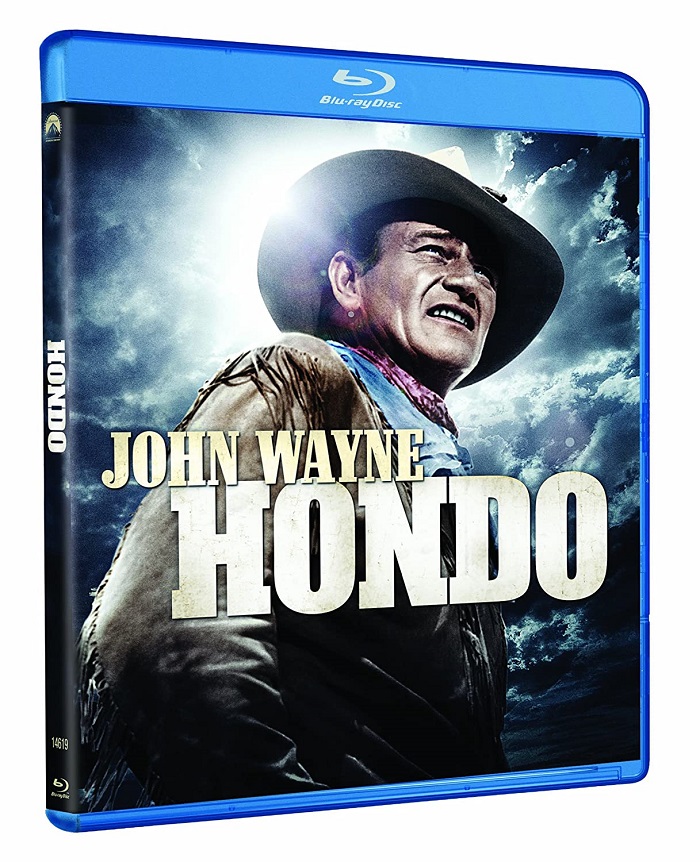
Based on Louis L’Amour’s short story “The Gift of Cochise,” Hondo Lane (John Wayne) wearily walks out of the New Mexico desert after Apaches stole his horse. He arrives at the Lowe ranch where Angie (Geraldine Page in her film debut) and young son Johnny (Lee Aaker) live. She says her husband Ed is nearby working, but the condition of the ranch tells a different story. Hondo performs chores for his board and keep. He leaves to inform the Army Cavalry about the Apaches going on the warpath due to the U.S. breaking their treaty.
After Hondo leaves the ranch, Chief Vittorio (Michael Pate) and the Apaches show up. Vittorio decides to offer the Lowes protection, taking Johnny under his wing and making him a blood brother. He also orders Angie to marry one of his men because Johnny needs a father, but she refuses because she’s still married, which leads Vittorio to ask where her husband is.
Once in town, Hondo tells Major Sherry (Paul Fix) about the loss of the Calvary troop that was escorting settlers north due to the Apaches. Hondo also has a few run-ins with a fellow, who turns out to be Ed Lowe (Leo Gordon). Fearing for Angie and Johnny’s safety, Hondo goes back to protect them. Ed, who is more interested in revenge than his abandoned family, follows. Along the way, Hondo tussles with Ed and the Apaches before returning to the ranch. After spending a few weeks together, Hondo and Angie grow close.
Calvary troops intent on pushing the Apaches back stop at the ranch to see what Hondo knows. He warns them they are going to get ambushed, which turns out to be correct. The troops head back to town with settlers, including Hondo, Angie, and Johnny, in tow. The Apaches aim to stop them from their destination.
Hondo delivers many of the elements fans of classic Westerns enjoy. There’s a hero, noble and selfless, who always does the right thing no matter the situation. The script is well written and takes interesting, believable turns as the plot moves along. The film is a step above many Westerns by offering an understandable motive for the Apaches’ response, which along with Vittorio’s concern for Johnny keeps them from coming off as mindless caricatures. The landscapes of the American Southwest and Mexico shooting locations are impressive. The action scenes are well choreographed and shot, particularly the climactic sequence, which was directed by an uncredited John Ford.
The centerpiece of the film’s success is John Wayne’s performance. Though originally intended for Glenn Ford, who declined because he didn’t like director John Farrow, the role of Hondo seems tailor-made for Wayne. He’s a man’s man: a gentleman with the ladies, a handyman around the homestead, and the man you want by your side in a fight. He’s also enlightened, offering bits of wisdom, such as “A man oughta do what he thinks is best” and “A long time ago I made me a rule. I let people do what they want to do.” Being so well rounded is what makes Hondo stand out in Wayne’s filmography.
The video has been given a 1080p/MPEG-4 AVC encoded transfer displayed at an aspect ratio of 1.78:1. At times, the image looks very good, but the quality is inconsistent. There are warm tones in the colors. Textures are sharp, from the fringes on Hondo’s coat to the stitching and wear on his saddle.
In contrast, there are many scenes where colors are faded and the focus is soft. Examples of the disparity include when Ed complains about the Calvary, the image doesn’t look as sharp or colorful. Also, Hondo being captured by Apaches. The soft focus can be seen when Angie discovers Hondo’s identity. She is out of focus in the background. Close-ups of Vittorio, before becoming blood brothers with Johnny and before the torture of Hondo, are so soft they almost look out of focus. Both flaws can be seen when Lennie (James Arness) tries to blackmail Hondo. The scene starts with a soft focus and faded colors. After Hondo punches Lennie and a cut to and from Angie, the image has a sharper focus and brighter colors.
While presented here in 2D, Hondo was shot in 3D, which was all the rage at the time it was made. There are a few shots where action goes straight at the camera, such as a galloping horse as the film opens and a few thrusts during a knife fight, but those few moments don’t detract.
The Dolby TrueHD 5.1 track is adequate but not much better than the Dolby TrueHD Mono track. The music plays softly in the surrounds. The effects are limited in loudness and their placement, some sounding flat and hollow.
Extras include an introduction by critic Leonard Maltin (SD, 3 min). There’s an audio commentary by Maltin and Western Historian Frank Thompson. They have an enjoyable and informative conversation together about many aspects of the film. Aaker also appears with his own reminiscences, edited into the track from a separate session. “The Making of Hondo” (SD, 43 min) is comprised of three subfeatures. Also called “The Making of Hondo,” interviews with Thompson, Pate, and Aaker present their perspectives. Maltin narrates “Profile: James Edward Grant,” about Wayne’s favorite screenwriter, and “The John Wayne Stock Company: Ward Bond,” which spotlights the actor, who plays scout Buffalo Baker. There’s yet even more Maltin when he appears in “From the Batjac Vaults” (SD, 2 min) where he interviewed Michael Wayne about the re-release of Hondo for Entertainment Tonight from October 26, 1994. A woman from the Museum of Indian Arts and Culture offers history and insight about “The Apache” (SD, 15 min). There’s also a Photo Gallery (HD) and a Theatrical Trailer (HD, 3 min).
Though the A/V specs on the Blu-ray might not be up to par, Hondo is a worthwhile film to have in the collection.